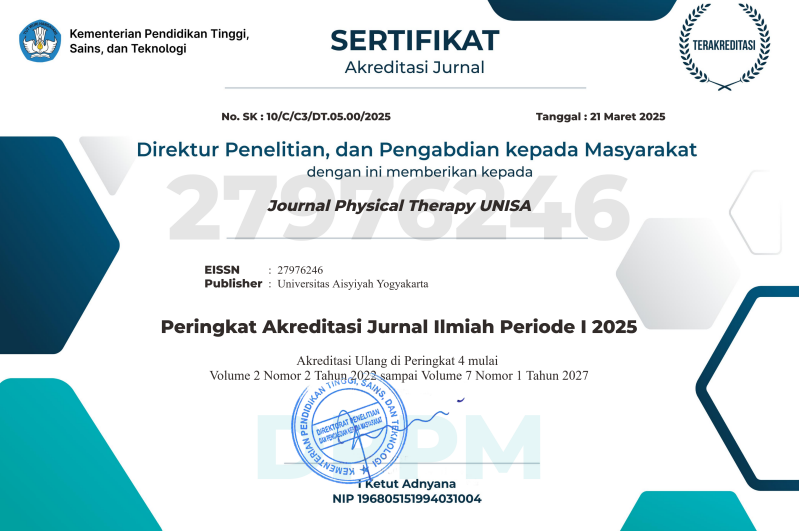The effect of physical therapy intervention on pain and functional in pre-operative lumbar spinal stenosis (LSS) patients
DOI:
https://doi.org/10.31101/jitu.2664Abstract views 734 times
Keywords:
LSS, Manual therapy, latihan/exerciseAbstract
Downloads
References
Atlas SJ, Keller RB, Wu Ya. (2005). Long-term outcomes of surgical and nonsurgical management of Lumbar Spinal Stenosis: 8 to 10 year results from the maine lumbar spine study. Spine (Phila Pa 1976), 30:936-43. https://doi.org/10.1097/01.brs.0000158953.57966.c0.
Backstorm KM, Whitman JM, Flynn TW. (2011). Lumbar Spinal Stenosis -diagnosis and management of the aging spine. Journal of Manual therapy 16 (4):308-17. https://doi.org/10.1016/j.math. 01.010.
Breslau J. Seidenwurm D. (2000). Sosioeconomic aspects of spinal imaging : impact of radiological diagnosis on lumbar spine-related disability. Topic in Magnetic Resonance Imaging: Top Magn Reson Imaging 11 (4) : 218-23. https://doi.org/ 10.1097/00002142-200008000-00002.
Creighton D.S, Krauss J, Marcoux B. (2006). Management of Lumbar Spinal Stenosis throught the Use of Translantoric Manipulation and Lumbar Flexion Exercise : A Case Series. The Journal of Manual & Manipulative Therapy Vol.14 No.1 E1-E10. https://doi.org/ 10.1179/jmt.2006.14.1.1E
Dagenais S, Haldeman S. (2012). Evidence-based management of low back pain. St. Louis Missouri: Mosby, Inc; Hal 1-12.
Herling D, Kessler R.M. (2006). Management of Common Musculoskeletal Disorders, Physical Therapy Principles and Methods.4th Edition. Lippincott William & Wilkins, A woter Kluwer Company. Philadelphia, Pensylvania, USA, Hal 112, 123-124, 854-855
Hicks GE,Morone N,Weiner D.K. (2009). Degenerative Lumbar Disc and Facet Disease in Older Adults:Prevalence and Clinical Correlates. Spine (Phila Pa 1976). 20; 34(12): 1301–1306. https://doi.org/10.1097/BRS.0b013e3181a18263
Jones A.D.R, Wafai A.M, Easterbrook A.L. (2014). Improvement in low back pain following spinal decompression:observational study of 119 patients. Eur Spine J 23:135–141/ https://doi.org/10.1007/s00586-013-2964-5
Kalichman L, Hunter D.J. (2008). Diagnosis and conservative management of degenerative lumbar spondylolisthesis, Eus Spine J 17: 327-335. https://doi.org/10.1007/s00586-007-0543-3
Kim ER, Kang MH, Kim YG, Oh JS. (2014). Effect of home program on the self report disability index and gait parameters in patients with Lumbar Spinal Stenosis. J.Phys.Ther.Sci. 26(2): 305-307. https://doi.org/10.1589/jpts.26.305
Kovacs FM, Urrútia G, Alarcón JD. (2011). Surgery Versus Conservative Treatment for Symtomatic Lumbar Spine Stenosis: a systematic review of randomized controlled trials. SPINE(Phila Pa 1976) 36(20):E1335-51. . https://doi.org/10.1097/BRS.0b013e31820c97b1.
Legaspi O, Edmond SL. (2007). Does the evidence support the existence of lumbar spine coupled motion? A critical review of the literature. J Orthop Sports Phys Ther. 37(4):169-78. https://doi.org/10.2519/jospt.2007.2300.
McGill S. (2002). Low Back Disorder, evidence-based prevention and rehabilitation. Human Kinetics USA, ISBN : 0-7360-4141-5 page 60-61. https://doi.org/10.2310/6640.2003.37832
Padua L, Padua R, Mastantuoni G, et al. (2004). Health-related quality of life after surgical treatment for lumbar stenosis. Spine (Phila Pa 1976), 29: 1670-1674.https://doi.org/10.1097/01.brs.0000132313.84338.54.
Pua YH, Cai CC, Lim KC. (2007). Treadmill walking with body weight supports is no more effective than cycling when added to an exercise program for Lumbar Spinal Stenosis : a randomized controlled trial. The Australian Journal of physiotherapy 52(2) : 83-9 (Pubmed: 17535143) https://doi.org/10.1016/s0004-9514(07)70040-5.
Reiman MP, Harris JY, Cleland JA. (2009). Manual Therapy Interventions for Patiens with Lumbar Spinal Stenosis: a Systematic review. New Zealand Journal of Physiotherapy 37 (1) 12-28. www.highbeam.com/doc/1G1-207945598.html
Takahashi K, Miyazaki T, Takino T, Matsui T, Tomita K. (1995). Epidural pressure measurements: relationship between epidural pressure and posture in patient with lumbar spinal tenosis. Spine 20: 650-653. PMID: 7604339
Weinstein J.N.,Tosteson D.T,AnnaT, Blood E,Herkowitz H, Cammisa F, ToddAlbert T, Boden S.D, Hilibrand A, Goldberg H, Berven S, An H (2010). Surgical versus Non-Operative Treatment for Lumbar Spinal Stenosis Four-Year Results of the Spine Patient OutcomesResearch Trial (SPORT), Spine (Phila Pa 1976). 35(14): 1329–1338. https://doi.org/10.1097/BRS.0b013e3181e0f04d
Whitman JM, Flynn TW, Childs JD, Wainner RS, Gill HE, Ryder MG,Garber MB, Bennett AC, Fritz JM (2006). A comparison between two physicaltherapy treatment programs for patients with Lumbar Spinal Stenosis : arandomized clinical trial. Spine (Phila Pa 1976)31(22):2541-2549. https://doi.org/10.1097/01.brs.0000241136.98159.8c.
Downloads
Published
How to Cite
Issue
Section
License
Copyright (c) 2022 Dwi Yuningsih, Danur Setiawan

This work is licensed under a Creative Commons Attribution-ShareAlike 4.0 International License.









